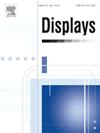Subjective and objective quality evaluation for industrial images
IF 3.7
2区 工程技术
Q1 COMPUTER SCIENCE, HARDWARE & ARCHITECTURE
引用次数: 0
Abstract
Recently, the demand for ever-better image processing technique continues to grow in field of industrial scenario monitoring and industrial process inspection. The subjective and objective quality evaluation of industrial images are vital for advancing the development of industrial visual perception and enhancing the quality of industrial image/video processing applications. However, the scarcity of publicly available industrial image databases with reliable subjective scores restricts the development of industrial image quality evaluation (IIQE). In preparation for a vacancy, this article first establishes two industrial image databases (i.e., industrial scenario image dataset (ISID) and industrial process image dataset (IPID)) for assessing IIQE metrics. Furthermore, in order to avoid overwhelming industrial image nuances due to the wavelet subband summation, we then present a novel industrial application subband information fidelity standard (SIFS) evaluation method using the channel capacity of visual signals in wavelet domain. Specifically, we first build a visual signals channel model based on perception process from human eyes to brain. Second, we compute and compare the channel capacity for reference and distorted images to measure the information fidelity in each wavelet subband. Third, we sum over the subbands for information fidelity ratio to obtain the overall quality score. Finally, we fairly compare some up-to-date and our proposed image quality evaluation (IQE) methods in two novelty industrial datasets respectively. Our ISID and IPID datasets are capable of evaluating most IQE metrics comprehensively and paves the way for further research on IIQE. Our SIFS model show a remarkable performance comparing with other up-to-date IQE methods.
工业图像的主观和客观质量评估
近来,在工业场景监控和工业过程检测领域,对更好的图像处理技术的需求不断增长。工业图像的主观和客观质量评价对于推动工业视觉感知的发展和提高工业图像/视频处理应用的质量至关重要。然而,具有可靠主观评分的公开工业图像数据库的匮乏限制了工业图像质量评估(IIQE)的发展。为了填补空缺,本文首先建立了两个工业图像数据库(即工业场景图像数据集(ISID)和工业过程图像数据集(IPID)),用于评估 IIQE 指标。此外,为了避免小波子带求和导致工业图像细微差别过大,我们随后提出了一种利用小波域视觉信号信道容量的新型工业应用子带信息保真度标准(SIFS)评估方法。具体来说,我们首先根据从人眼到大脑的感知过程建立视觉信号信道模型。其次,我们计算并比较参考图像和失真图像的信道容量,以衡量每个小波子带的信息保真度。第三,我们对各子带的信息保真度比率进行求和,得出总体质量得分。最后,我们分别在两个新颖的工业数据集上对一些最新的图像质量评估(IQE)方法和我们提出的方法进行了公平的比较。我们的 ISID 和 IPID 数据集能够全面评估大多数 IQE 指标,为 IIQE 的进一步研究铺平了道路。与其他最新的 IQE 方法相比,我们的 SIFS 模型表现出了卓越的性能。
本文章由计算机程序翻译,如有差异,请以英文原文为准。
求助全文
约1分钟内获得全文
求助全文
来源期刊

Displays
工程技术-工程:电子与电气
CiteScore
4.60
自引率
25.60%
发文量
138
审稿时长
92 days
期刊介绍:
Displays is the international journal covering the research and development of display technology, its effective presentation and perception of information, and applications and systems including display-human interface.
Technical papers on practical developments in Displays technology provide an effective channel to promote greater understanding and cross-fertilization across the diverse disciplines of the Displays community. Original research papers solving ergonomics issues at the display-human interface advance effective presentation of information. Tutorial papers covering fundamentals intended for display technologies and human factor engineers new to the field will also occasionally featured.
 求助内容:
求助内容: 应助结果提醒方式:
应助结果提醒方式:


